Facility Introduction
Scholarly Communication Center
Library
The Sapporo Medical University Library is located on the 2nd to 4th floors of the Basic Medical Research Building. The library is equipped with retrieval devices and multimedia PCs. The network provided by the Information Center of Computer Communication is available throughout the facilities. The Library's operational system has achieved a high reputation among its many users. The floors house collections, reading room, carrel desks, group study rooms and pleasant study environments. The library is open year-round, 24 hours a day. A valid ID Card is required for entry.
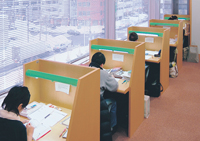
Carrel desks
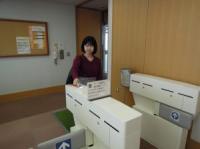
Library entrance
Information Center of Computer Communication
The Information Center of Computer Communication was established in April 1999, to assist with the development of health professionals, to support academic research and to contribute to the regional health of Hokkaido. This center contributes to the field of medicine by meeting the needs of today's highly-networked information society. Its functions include: (1)technical support for information exchanges within the university via of an information and telecommunication infrastructure and its stable operation and management; (2)research support by scientific liverature evalution tool and provision of software for purposes of analysis; (3)educational support by deployment of the necessary equipment to rooms specifically designed for computer use in classes; (4)support of rural medicine by medical data communication and teleconferences to and from distant locations.
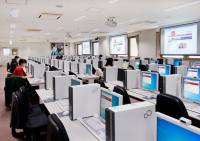
Computer Suite
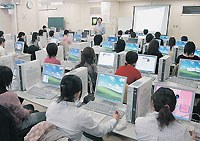
Computer Suite
Collaboration Center for Community and Industry
Department of Community and Industry Partnerships
The Department of Community and Industry Partnerships presides over the acquisition of external funds, accounting and management related to research activities and for handling external communication related to the various social contribution of the university. The department provides researchers at the university with support to acquire research funds as well as collaborating with other universities and institutions to promote education, research and academia-industry collaborations.
The funds provided by companies, organizations and individuals are used for the development of education and academic research, improvement of medical education facilities and environmental improvement of the university hospital. They are also used to support programs such as the education and research activities of researchers of the university, international exchanges of researchers and students, short-term study abroad programs and open lectures to promote understanding of the academic activities of the university.
The funds provided by companies, organizations and individuals are used for the development of education and academic research, improvement of medical education facilities and environmental improvement of the university hospital. They are also used to support programs such as the education and research activities of researchers of the university, international exchanges of researchers and students, short-term study abroad programs and open lectures to promote understanding of the academic activities of the university.
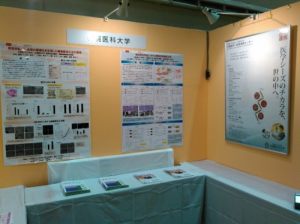
Exhibition and Presentation of Sapporo Medical University’s research
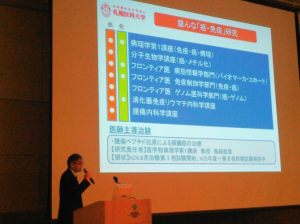
Exhibition and Presentation of Sapporo Medical University’s research
Department of Intellectual Property
The Department of Intellectual Property manages the research findings of the university by utilizing patents or taking other appropriate measures. The department also provides consultation regarding research strategies to receive a patent and technology transfer. It also handles the administrative work related to MTA (Material Transfer Agreement) necessary for providing research materials to other universities or institutions.
Education on intellectual property: Educational programs of intellectual property are provided to graduate students, medical researchers and community healthcare practitioners. Such programs are organized to meet the needs and interest of attendees and cover information from basic knowledge to the process of technology transfer.
Translational research support: The Department of Intellectual Property is involved in translational research projects such the All Hokkaido Formation of an Advanced Medicine/Healthcare Base, which is a program conducted in collaboration with Hokkaido University and Asahikawa Medical University, in cooperation with other related sections.
Education on intellectual property: Educational programs of intellectual property are provided to graduate students, medical researchers and community healthcare practitioners. Such programs are organized to meet the needs and interest of attendees and cover information from basic knowledge to the process of technology transfer.
Translational research support: The Department of Intellectual Property is involved in translational research projects such the All Hokkaido Formation of an Advanced Medicine/Healthcare Base, which is a program conducted in collaboration with Hokkaido University and Asahikawa Medical University, in cooperation with other related sections.
Biomedical Museum
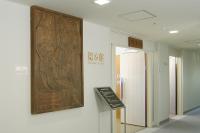
Entrance to Biomedical Museum
In response to the recent increases in the number of medical education institutions, the Biomedical Museum caters to study tours of students.